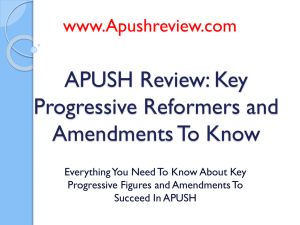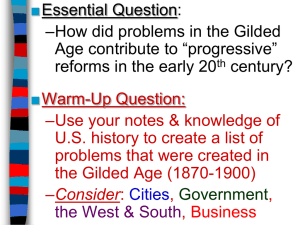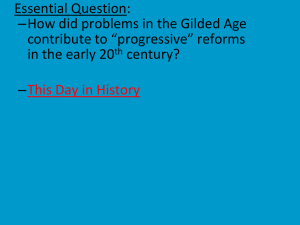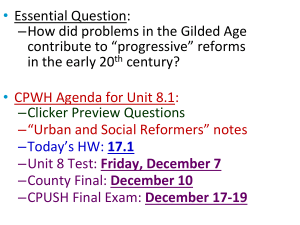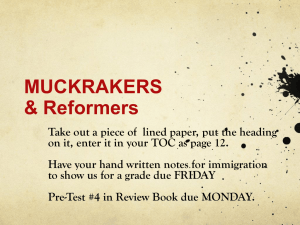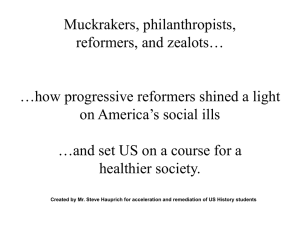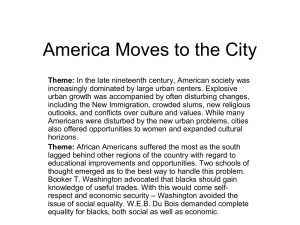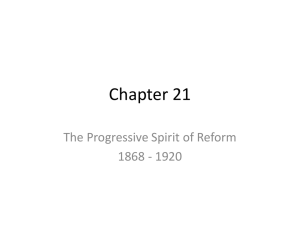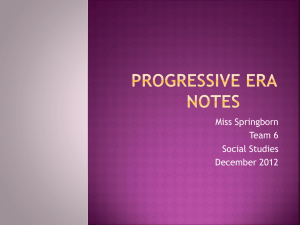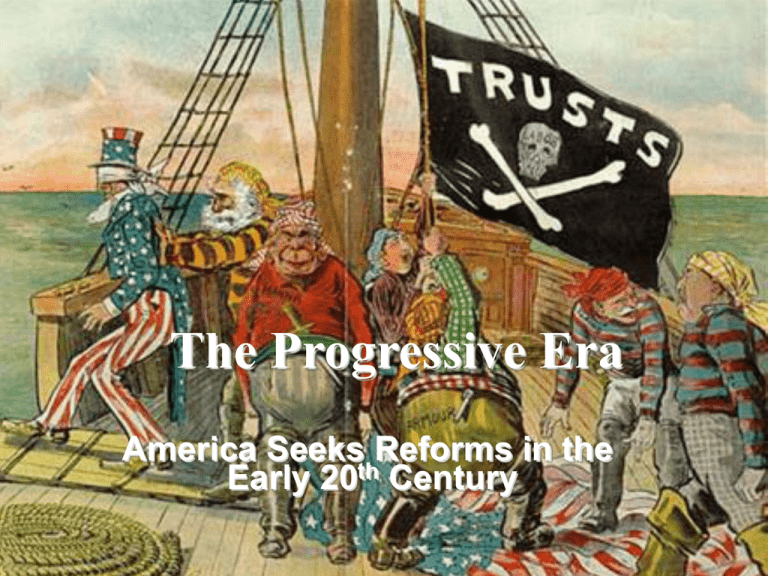
The Progressive Era
America Seeks Reforms in the
Early 20th Century
■Essential Question:
–How did problems in the Gilded
Age contribute to “progressive”
reforms in the early 20th century?
■Warm-Up Question:
–Use your notes & knowledge of
U.S. history to create a list of
problems that were created in
the Gilded Age (1870-1900)
–Consider: Cities, Government, the
West & South, Business
Urban Reform During the
Progressive Era (1890-1920)
■ From 1890 to 1920, reformers tried
to clean up problems (“progress”)
created during the Gilded Age:
–Cities were plagued by slums,
crime, disease, tenements
–Corporate monopolies limited
competition & workers’ wages
The Social Gospel Movement
■ In the 1880s, many middle-class
Protestant Christians embraced the
Social Gospel movement:
–To honor God, people must put
aside their own desires & help
other people, especially the poor
–These ideas helped inspire
Progressive reform in U.S. cities
Urban Progressive Reformers
■ One of the earliest progressive
reforms was the settlement house
movement led by Jane Addams
–Addams’ Hull House in Chicago
offered baths, cheap food, child
care, job training, health care to
poor citizens
–Her efforts inspired reformers in
other cities to build settlement
houses to assist the poor
Urban Poverty
Hull House Nursery
Urban Progressive Reformers
■ Urban reformers tried to improve the lives of
poor workers & children
– YMCA created libraries & gyms for young
men & children
– Salvation Army
created soup
kitchens &
nurseries
– Attempt to end
child labor
Muckrakers
■ In addition to the Social Gospel,
progressive reformers were aided by a
new, investigative journalism:
– Muckrakers were journalists who
exposed problems like poverty,
corruption,
monopolization
Michael Moore
(“Investigate, Educate, Legislate”)
What did Jacob Riis’
How the Other Half Lives (1890) expose?
Jacob Riis’ How the
Other Half Lives
(1890) exposed
urban poverty & life
in the slums
What did Ida Tarbell’s
The History of Standard Oil (1904) expose?
Ida Tarbell’s The
History of Standard
Oil (1904) revealed
Rockefeller’s
ruthless business
practices & called
for the break-up of
large monopolies
What did Upton Sinclair’s
The Jungle (1906) expose?
Upton Sinclair’s
The Jungle (1906)
revealed the
unsanitary
conditions of
slaughterhouses
& led to gov’t
regulation of
food industries
Conclusions
■ Progressive movement -- attempt to fix
urban problems
– Reformers lacked unity & were
dedicated to their own causes
– But their efforts led to a shift: gov’t
began to take responsibility for
citizens & intervene in their lives
■ Essential Question:
–How did Progressive reformers
attempt to improve the lives of
women & African-Americans?
■ Warm-Up Question:
–What was the “Social Gospel”?
–What was a “muckraker”?
–Who was the more important
reformer: Jane Addams
The Women’s Movement
■ In the Gilded Age, women had more
opportunities beyond marriage:
– New urban jobs
as secretaries,
store clerks, &
telephone
operators gave
a sense of
independence
– More girls graduated from high school
& attended universities
The Women’s Movement
■Women played an important role as
Progressive reformers:
–Jane Addams led the settlement
house movement
–Muckraker Ida Tarbell exposed
monopoly abuses of Standard Oil
The Women’s Movement
■ Women reformers began to call
attention to their own lack of rights:
– In most states, married women could
not divorce or own property
– Women could not vote, but AfricanAmerican, immigrant, & illiterate men
could
– Women workers were paid less than
men for doing the same jobs
– Middle & upper class women were
expected to serve domestic & child
rearing roles in the home
Women’s Suffrage
■ The most significant reform for
women was voting rights (suffrage)
– Women demanded suffrage since
Seneca Falls in 1848
– Frustrated in 1870 when the 15th
Amendment gave African-American
men the right to vote but not
women
– 1890, National American Women
Suffrage Association (NAWSA) was
formed
Suffragettes
1900 -- 10 million bikes
on the road
The bicycle was a new
invention that took the
nation by storm
– every manufacturer had
a ‘ladies model.’
Of course, long dresses and
bustles did not lend
themselves to riding bikes
–women went to more
comfortable, useful
clothing
–Even Susan B. Anthony
was a convert “Bicycling
did more to emancipate
women than anything in
the world.”
Anti-Suffrage Pamphlet (c.1918)
◼
“Housewives!
◼ You do not need a ballot to clean out your sink
spout. A handful of potash and some boiling
water is quicker and cheaper…
◼ Why vote for pure food laws, when your
husband does that, while you can purify your
Ice-box with chlorine and lime-water?”
◼
“Vote NO on Woman Suffrage
◼ BECAUSE 90% of the women either do not want it, or do not
care.
◼ BECAUSE it means competition of women with men instead of
co-operation.
◼ BECAUSE 80% of the women eligible to vote are married and can
only double or annul their husband’s votes…
◼ BECAUSE in some States more voting women than voting men
will place the Government under petticoat rule.
◼ BECAUSE it is unwise to risk the good we already have for the
evil which may occur. “
Women’s Suffrage
■ NAWSA leaders Susan B. Anthony &
Carrie Chapman Catt pressured states
to let women vote & called for a national
suffrage amendment
– By the early 1900s, most western
states allowed women to vote
– Finally in 1920, the states ratified the
19th Amendment giving women to
right to vote
19th Amendment:
The right of the citizens
of the United States to
Women’s
vote shall not be denied
or abridgedSuffrage
by the
United States or
by any
Before
State on account1900
of sex.
Reform for African-Americans
Plessy
v Ferguson (1896):
■ By 1900,
African-Americans
were in
Segregation
does not
violate the
need
of progressive
reform
th amendment & can be used as
14
– 80% of lived in rural areas in the
long
as
separate
facilities
are
equal
South, most as sharecroppers
(“separate but equal”)
– Poll taxes & literacy tests limited
African-American voting rights
– Lynching & violence were common
– Plessy v. Ferguson (1896)
allowed Jim Crow laws to
segregate in restaurants, hotels,
schools
African-American Reforms
■ However, AfricanAmerican leaders were
divided on how to address
racial problems
– Booker T. Washington
was
Harvard educated,
The wisest among my race understand that
African-American
urbanequality
culture,is
the studied
agitation
of questions of social
was 1st president
Tuskegee
the&extremist
folly, andof
that
progress in the
enjoyment
of all the privileges that will come
University
must beCompromise”
the result of severe
and
– to
Hisus“Atlanta
stressed
constant struggle rather than of artificial
African-American
self-improvement
&
forcing.
accommodation with
whites
—Booker
T. Washington
African-American Reforms
■
W.E.B. DuBois was
more aggressive
■ DuBois led the Niagara
Movement in 1905
calling for immediate
We
claim
for ourselves
every single right
civil
rights,
integrated
that belongs to a free American,
schools,
&
promotion
political, civil and social, and until we get
ofthese
the “Talented
10thnever
” to be
theto
rights we will
cease
protest
and assail of
theAfricanears of America
next generation
—W.E.B. DuBois
American civil rights leaders
The NAACP
■ 1909, reformers formed the National
Association for the Advancement of
Colored People (NAACP) to fight for
African-American equality
–DuBios ran (The Crisis) publication to
call attention to the cause
–The NAACP used lawsuits to fight
segregation laws & voting
restrictions
Reforms for African-Americans
■ Unlike women, African-Americans
did not see significant changes:
–African-American reformers failed
to convince state or national
politicians to offer equality
–By the end of the Progressive
Era, segregation & lynching were
common throughout the South &
in many parts of the U.S.
■The End
Closure Activity
■ Examine excerpts of speeches by
Washington & DuBois
–What is the main idea of each?
–In one sentence, summarize the
approach of Washington &
DuBois regarding civil rights
–Whose approach was more
appropriate for the early 20th
century? Why?

